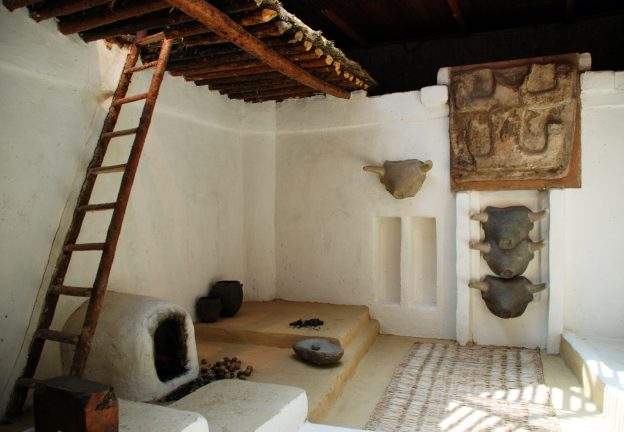
Inhabitants of Catalhoyuk entered their homes from the roof, using a ladder, as shown above in a reconstruction of a home. (Elelicht, Wikimedia Commons)
In Part 1 of this series, we discussed the unprecedented shift in human history known as the Neolithic Revolution. We learned that this change originated in what is now Iraq, Syria, Lebanon and Israel/Palestine and soon spread to surrounding areas like modern day Turkey. One of the most important sites excavated in Turkey is Çatalhöyük, which was discovered by archaeologist James Mellaart in 1958.
Mellaart continued to excavate Çatalhöyük until 1965, after which the site went unstudied until a new 25 year project was undertaken by Ian Hodder in 1993. This project ended in 2018, but archaeologists continue to publish new research using this rich source or archaeological data.
Çatalhöyük’s long period of excavation and its wealth of well-preserved artifacts and archaeological remains has made it an indispensable source of data about the Neolithic and subsequent periods.
The Invention of Wool, Milk and Ploughs
One new study of ceramics challenges the standard understanding of how agriculture affected human culture. In addition to talking about a Neolithic revolution, archaeologists have also theorized a secondary products revolution. This refers to animal byproducts that humans used, like milk, wool and the simple strength of animals, which humans harnessed to pull ploughs and carry heavy loads.
Each of these new technologies had far-reaching consequences. Milking animals meant that humans didn’t have to kill them in order to get food. The manipulation of wool led to new ways for making clothes. Using animals to pull ploughs and wagons meant that less people were needed to produce agricultural products. All of this, in turn, led to smaller human settlements that were more spread out.
For the past few decades, the dominant theory has been that this change occurred after the Neolithic, during what is called the Chalcolithic, between 6000 and 3000 B.C.E. The new research being done at Çatalhöyük, however, shows that humans were making dairy products much earlier, probably already by the end of the Neolithic around 6000 B.C.E. Some previous research had yielded similar results, meaning that humans likely started cultivating milk soon after domesticating large mammals.
At Çatalhöyük, though, researchers were able to use a new method called liquid chromatography-tandem mass spectrometry (LC-MS). This process can detect traces of proteins, even after thousands of years. In the case of Çatalhöyük pottery fragments, LC-MS not only revealed that the inhabitants were manufacturing dairy products, it also showed what kind of animals the milk came from. From this we know that people at Çatalhöyük drank milk from both sheep and goats.

Unlike a modern city, the inhabitants of Çatalhöyük lived in houses that were all clustered together, with no streets or alleys separating one resident from another. (Omar Hoftun, Wikimedia Commons)
The Legacy of Cities
It should be emphasized that Çatalhöyük was probably not that unique among the other urban areas during the Neolithic. This is precisely why it is such an important site. What archaeologists learn from it can help shed light on the way agriculture and urbanization changed the way people lived throughout the ancient Middle East.
Now that most people living on earth get their food from agriculture and live in a human settlement of similar size to Çatalhöyük and other Neolithic cities, it’s easy to overlook the very specific effects and consequences of the Neolithic Revolution.
The benefits of this process are obvious. Milk and wool are two things many people would not want to live without. At the same time, as more research is done at sites like Çatalhöyük, the dark side of cities is becoming more and more apparent.
One recent study conducted at Çatalhöyük shows that the inhabitants were plagued by a high infection rate, likely a consequence of everyone living very close together. This level of population density also probably led to an increase in violence, something the researchers also noticed by looking at fractured skulls.
All of this means that studying Çatalhöyük and its role in the Neolithic Revolution is not simply an exercise in trying to understand an ancient society. The origins of many problems facing the world in the 21st century, like violence, disease and overpopulation, can be found in the societies of the Middle East thousands of years ago.
Sources and Further Reading
- Hendy, J., et al. (2018) Ancient proteins from ceramic vessels at Çatalhöyük West reveal the hidden cuisine of early farmers. Nature Communications. 9 (4064).
- Grabmeier, J. Çatalhöyük: 9,000 years ago, a community with modern urban problems. Phys.org, June 17, 2019.
- Greenfield, H. J. (2010). The Secondary Products Revolution: The Past, The Present and The Future. World Archaeology. 42 (1), 29-54.









